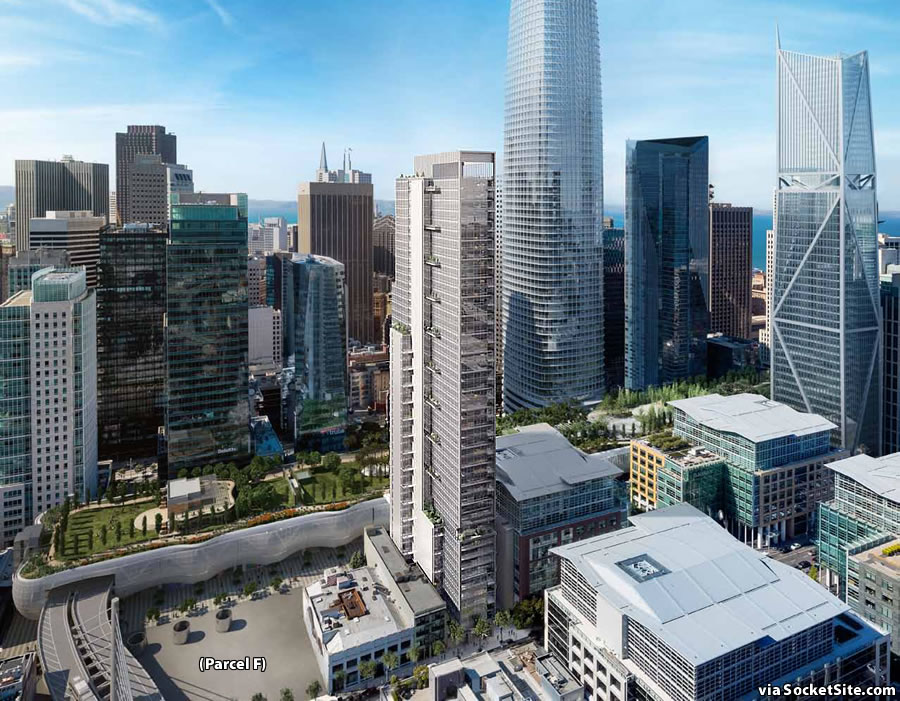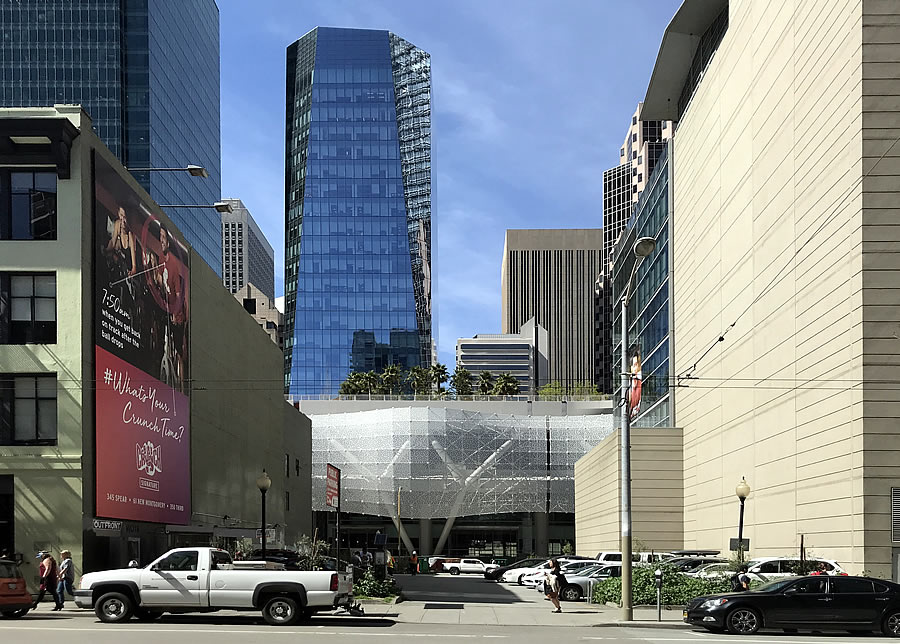As we outlined early last year, while plans for a skinny 495-foot-tall tower with up to 334 condos, or 72 condos over a 273-room hotel, “depending upon market conditions,” were approved to rise on the downtown parking lot parcel at 524 Howard Street back in 2016, the ground has yet to be broken.
Having already been extended three times, the operators of the parking lot on the parcel, which is technically a temporary, non-conforming use, were granted a fourth extension last year, an extension which specifically allowed for the parking lot to continue operating up until the entitlements for the tower expired, an expiration which is slated to occur next week.
At the same time, Crescent Heights, which acquired the un-entitled parcel out of foreclosure in 2012 and had been touting “coming soon” since 2013, has quietly sold the parcel and plans to a group of twelve investors for $78 million, based on a review of the deed and the transfer tax paid.
And with that in mind, and no progress having been made in terms of actually securing building permits for the tower, American West Parking is now seeking authorization to continue to operate the “temporary” Transbay District parking lot for (at least) another two years.


We have so many parking lots in SF’s “downtown core” it’s obscene. I counted 10+ along 5th street between Market & Townsend this week. Would love to see a tax on empty lots / surface parking across the entire city to encourage a quicker changes in use (and use the $$ to pay for transit improvements).
These developments are not going forward because they cannot get financing, not because anyone thinks running a parking lot is the best use of the land. So, a parking lot tax would do nothing to encourage quicker development. It would just be a cost of doing business, and the developers would pay it and take a tax deduction for the expense, and that would be all that would happen.
If a property owner wants to maintain a surface parking lot (for whatever reason—financing or otherwise) it’s still a drag on central city neighborhoods that encourages driving and ought to be contributing more to transit.
By all means, do everything you can to make the city less livable for residents and force everyone’s lifestyle into the mode you think best. Cars are evil so punish drivers just trying to get where they need to go and work for a living without spending an exceptionally unpleasant hour crammed into a bus with germ-spreading fellow humans.
Are you aware of climate change/air pollution? Should those offenses not be punished?
Won’t haneys new increased fees on developers cause more pain and cause less developments to be built
It’s certainly possible. And the City’s Office of Economic Analysis projected that the effective 6 percent increase in non-land related development costs for large office projects would result in an average of 125,000 to 140,000 fewer square feet of office space being developed per year. But the City’s analysis didn’t take into account the impact of Proposition M – which is already metering development with a backlog of projects now competing to get built.
You can always count on developers to keep their promise(s), especially those made at community meetings.
It’s gotta happen at some point, but it’s sad to see all of these projects take a [dump].
There have to be at least a dozen or so really promising developments that probably won’t even get started for another 4 years, let alone finish before the mid to late-20s.
Yeah, I’ve been wondering if the shortage of labor is putting a cap on the number of simultaneous projects—meaning there’s just not enough trained contractors/dev teams in the Bay Area for the (historically mediocre) building boom we have going on. Does labor ever lower its rates during recessions when contractors are out of work?
Yes, labor costs are the reason for delays of any project at this point in the cycle. There aren’t enough bodies in construction for the costs not to fluctuate with the number of projects breaking ground. It’s a seller’s market and the sellers are GC’s. Underwriting a project of this size with prevailing wage (union labor) shrinks margins to the point where the sponsor has to pump the brakes or risk losing equity. A further fee burden would be even more detrimental.
Also, SF construction costs are the highest of any metro in the world. Construction workers are fluid and move to markets with the most construction opportunities and right now that is not SF. Check out the crane count for an idea of areas that are really booming. And places construction workers are moving to.
Wrong, SF is booming in terms of crane count.
Or more to the point (and more recently): Housing Pipeline in San Francisco Slips but Building Actually Jumps
The RLB Crane Index report from the beginning of the year indicates that San Francisco experienced a year-over-year increase in the number of cranes and is one of the most heavily craned cities in the US.
In fact, as of Q2’19, San Francisco was the 9th most craned city in the US and Canada.
And the source for this factlet is the survey linked above – the one that surveyed 13 cities?
The only way to alleviate the labor shortage and reduce construction costs is to make it quicker and cheaper for construction workers to cross into San Francisco and congestion pricing for office workers choosing to drive into the city. There is a real cost to the construction worker that sits in an hour or two of gridlock in both productivity and the wages they will demand to deal with that loss of time.
Driving into the city and parking is frankly too cheap in the financial district, and you get gridlock as a result. I work in core downtown financial district, and my building only charges $20 per day for parking if you get in before 9:30 a.m. With toll and gas, you’re looking at around $35 a roundtrip from east bay, which is not a lot of money for people making 200k+. And there are a lot of people making more than that in the financial district. I have several coworkers who drive in every day. Why not? It’s only a few dollars more than taking the ferry, and most high earners would pay $20-30 to save even half an hour a day.
Constructions workers get burned in the process. They cannot afford to live in the City and raise a family. That’s a reality we are not capable of fighting. Why not accept that reality and instead make it quicker and cheaper for these folks to get to work from East Bay, Suisun, Vallejo, etc. Every permitted project should get a set number of toll waivers for the duration of the project, which can be used interchangeably as needed. Affordable housing projects should receive more number of waivers.
Combine with congestion pricing for everyone who shouldn’t be driving into the city, and you can reduce gridlock. Cities have successfully done this across the world.
Bay Bridge toll is an inequitable congestion pricing model because nobody from the peninsula has to pay anything to come into the city. That’s why we need a separate congestion pricing system.
It’d be interesting to know what kind of profit Crescent made on selling the lot/rights/plans for 78 million. Even though they surely made a gain, the lost opportunity cost likely took a big chunk out of that gain.
Condos at this time make no financial sense. The nearby Renzo tower project was recently abandoned as was the Oceanwide condo/hotel tower and the reverse flow tower proposed for RH. This lot will likely sit empty for years and my guess is that the eventual project built here will be a significantly scaled hotel.
Tax records suggest Crescent paid $15.85 million for the parcel which had been foreclosed upon in 2011 with an estimated $23 million then owed.
Another victim of the Trump effect.
This project has been sold 6 times over the last 15 years. The only person making money on this deal is the Broker. Timing has to be perfect to build a tall slender tower.
puts awful shadow on park.
#1 the sun is mostly bad for you
# 2 there are plenty of sun filled parks
#3 this only blocks sun in small parts of day.
#4 parks are overrun with homeless anyway
UPDATE: Parking Lot Slated for Extension as Tower Entitlements Expire